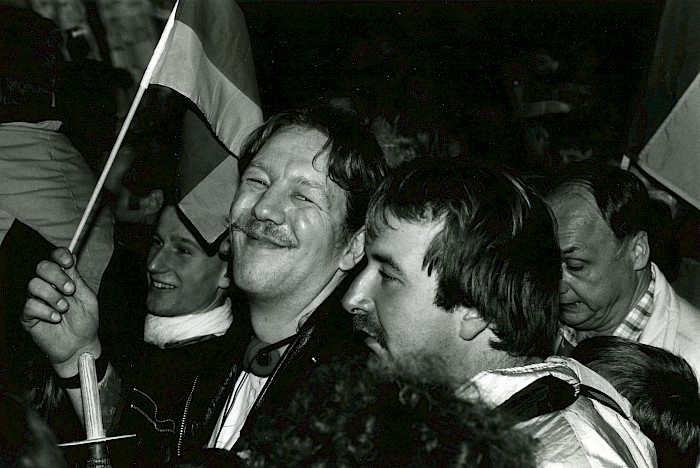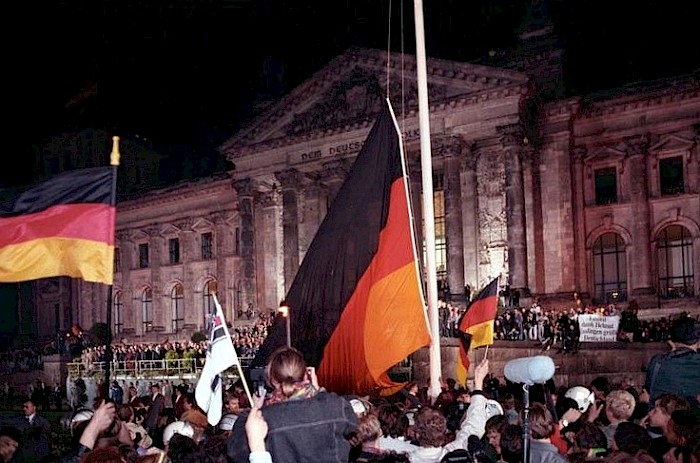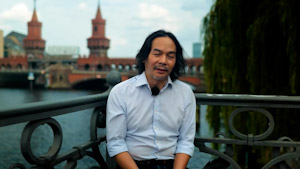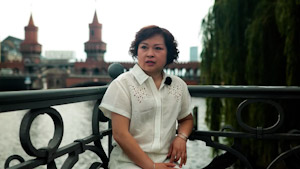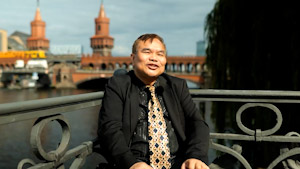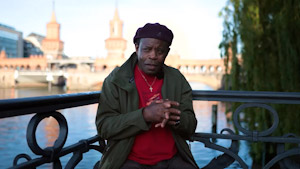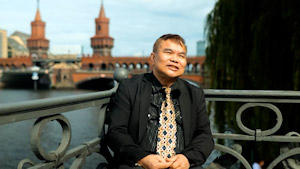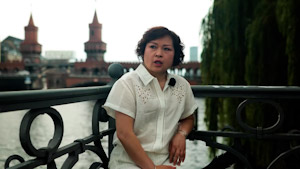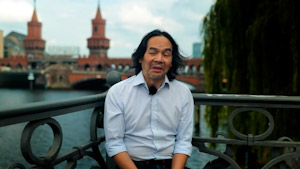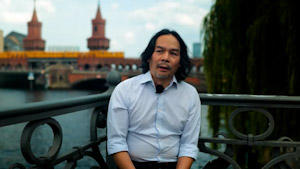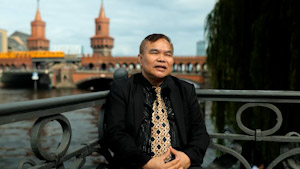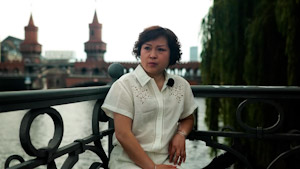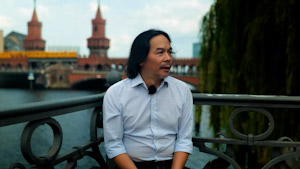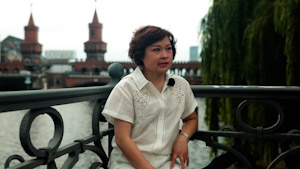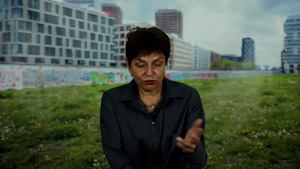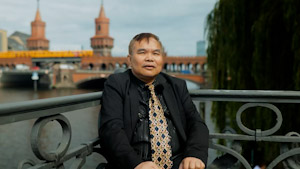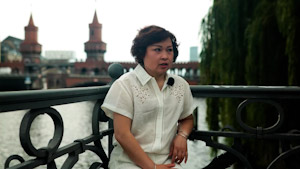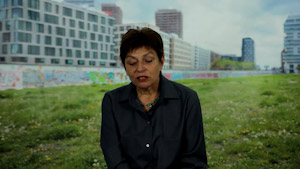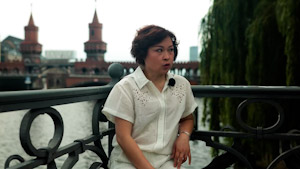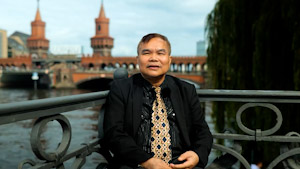1990: Mixed Feelings
“I knew many people in the East who led very complicated and unpredictable lives after the Wall fell.”
Not everybody felt that 1990 was a year to celebrate. The end of the GDR brought with it new freedoms and opportunities, as well as challenges. Many lives in Germany were upended by the political, economic and social restructuring. For those who had felt comfortable in the GDR or had come to terms with the system, German unification often represented the collapse of life as they had known it.
People celebrating the unification of the GDR and the Federal Republic of Germany on 3 May 1990
Thus, many East Germans remember the end of the GDR positively, but have uneasy or mixed feelings about the time after 1990. The things that had mattered in the GDR suddenly had less value in a unified Germany. Knowledge and skills acquired in the GDR were appreciated less and many workers discovered that their labor was no longer needed. Losing a job often meant losing one’s social network, too. But even more than the immediate social consequences, it was the public degradation that affected many East Germans most deeply.
In 1989, an estimated 129,000 people without German citizenship worked, studied and lived in the GDR. They came from Mozambique, Cuba, Angola, China and Algeria. The largest group—Vietnamese "contract workers"—accounted for nearly half of all foreigners. After the border opened, they faced an existential threat. Many also experienced racial violence.
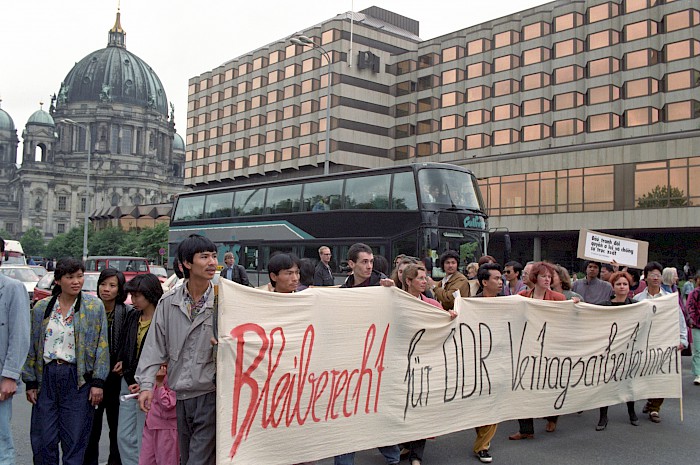
"Female Vietnamese contract workers encountered many problems in society."
With the introduction of the market economy and currency reform, many East German businesses were restructured or permanently closed. In the labor market, employers often gave preference to workers from Germany. The majority of "contract workers" lost not only their jobs, but also the factory housing that had accompanied their work. When the bilateral treaties between the GDR and other countries expired, their residence permits became invalid. The German state offered a bonus of 3,000 DM to those who left. Those who wanted to stay had to prove that they had a steady income and housing. The majority of the "contract workers" left the Federal Republic. But some remained in Germany and fought for the right to stay longer. They established families, started their own businesses, worked in various fields and became politically, socially and culturally active.
"The immigration office sent me to the employment office for the work permit. The employment office sent me to the immigration office for the residence permit. [...] So it was [... a] vicious circle."
The "contract workers" from Mozambique suffered a particular injustice. Up to 60 percent of their net monthly wages were deducted from their pay. The workers had a written assurance that the money would be transferred to an account in Mozambique and made available to them upon their return. To date, they have not received this money. Instead, the SED used it to offset the national debt of the Republic of Mozambique.
Racial Violence
"But I was also scared for my children. I don’t have many, but one child was born after the Wall fell, a daughter. But my ex-wife had also brought her child along. This child was white, not Black. But people always commented: ‘Oh, this woman is with a N*.’"
The period after the Wall opened was accompanied by increasing xenophobia and racism towards people who were not considered German. Many lost their jobs and livelihoods and also experienced social exclusion and hostility. State authorities tended to look the other way and remain inactive.
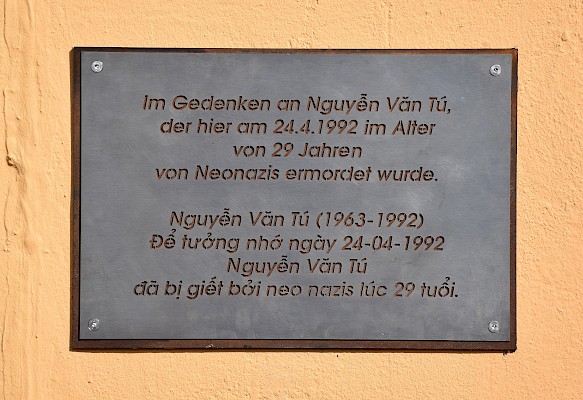
Violence culminated in pogroms and racist riots in the early 1990s. In September 1991, right-wing extremists attacked a home for asylum seekers in Hoyerswerda, Saxony, with Molotov cocktails and stones and drove out the residents – to the applause of many local citizens. There were also numerous attacks in western Germany. In Rostock-Lichtenhagen, an asylum seekers' center and a hostel for "contract workers" were besieged for several days and set on fire. In Mölln, right-wing extremists murdered three people in an arson attack on an apartment building where families of Turkish descent lived in 1992. The attacks culminated just six months later in May 1993, when five women and girls were killed in another arson attack in Solingen. Fourteen other family members were injured, some critically.
More attacks followed the widespread right-wing extremist violence of the early 1990s. Based on its research, the Amadeo Antonio Foundation estimates that at least 214 people have been killed by right-wing violence since 1990.
yet again?
one single case:
in november 1990
antonio amadeo from angola
in eberswalde
was beaten to death
by neo-nazis
a short time later
a white German woman
gives birth to their child
her house soon after
destroyed
oh, well
and the police
arrived so late
that it was too late
and the newspapers’ words
were so clipped
that it was like silence
and no picture on TV
about the murder case
May Ayim (1960-1996) is one of the most prominent representatives of the Black community in Germany. The West Berlin riverbank opposite the East Side Gallery is named after her.
Link to her biography and her legacy:
https://www.digitales-deutsches-frauenarchiv.de/akteurinnen/may-ayim#actor-content-about
https://www.amadeu-antonio-stiftung.de/perspektivwechsel-may-ayim-ufer-6687/
Contemporary witnesses remember
Additional information:
The project "Erinnern stören" collects hitherto marginalized perspectives that present the unification process in a new light: https://www.rosalux.de/publikation/id/43063/erinnern-stoeren
The journal "Aus Politik und Zeitgeschichte" published a volume on the German unification process in 2020.: https://www.bpb.de/apuz/312259/deutsche-einheit
The Bundeszentrale für politische Bildung published new perspectives on the fall of the Wall:
https://www.bpb.de/geschichte/deutsche-einheit/migrantische-perspektiven/
https://www.bpb.de/geschichte/deutsche-einheit/lange-wege-der-deutschen-einheit/
More information on right-wing extremist violence and its victims is found here:
https://www.migazin.de/2018/05/29/deutschlands-kapitel-eine-chronologie-uebergriffe/
https://www.amadeu-antonio-stiftung.de/todesopfer-rechter-gewalt/
https://www.einheit-interkulturell.de/themen/wiedervereinigung-und-rassismus/
The following website provides information about the pogroms in Hoyerswerda and Rostock-Lichtenhagen:
https://www.hoyerswerda-1991.de/start.html
https://zivilcourage-hoy.de/unsere-projekte-in-hoyerswerda/hoyerswerda-1991-gedenkwochenende/
https://www.bpb.de/politik/hintergrund-aktuell/254347/rostock-lichtenhagen
More information about "contract workers" in the GDR and after 1990 is found here:
https://vertragsarbeit-mosambik-ddr.de/
https://www.boell.de/de/2020/04/24/vietnamesische-vertragsarbeiterinnen-deutschland
https://www.politische-bildung-brandenburg.de/lexikon/vertragsarbeiter
Podcastfolge zu den Auswirkungen des Mauerfalls: Die Podcast-Reihe „Grenzerfahrung“ von der Stiftung Berliner Mauer entstand 2021 anlässlich des 60. Jahrestags des Mauerbaus und wurde gefördert von der Bundesbeauftragten für Kultur und Medien. Die Folge „Teilung – Einheit – Mauerspuren“ fragt nach dem Umgang mit den historischen Spuren der Teilung in Berlin. Expertinnen und Experten diskutieren über die Bedeutung der Spuren als Erinnerungs- und Bildungsorte, u.a. geht es um den Erhalt der East Side Gallery aus der Sicht der Stiftung Berliner Mauer und des Künstlers Günther Schaefer. In dieser Folge geht es außerdem um die Auswirkungen des Mauerfalls und des Vereinigungsprozesses auf Menschen, die als nicht Deutsch gelesen wurden. https://www.stiftung-berliner-mauer.de/de/stiftung/podcast-grenzerfahrung
